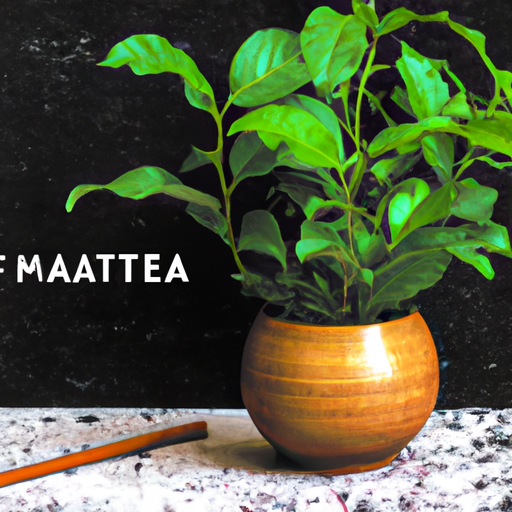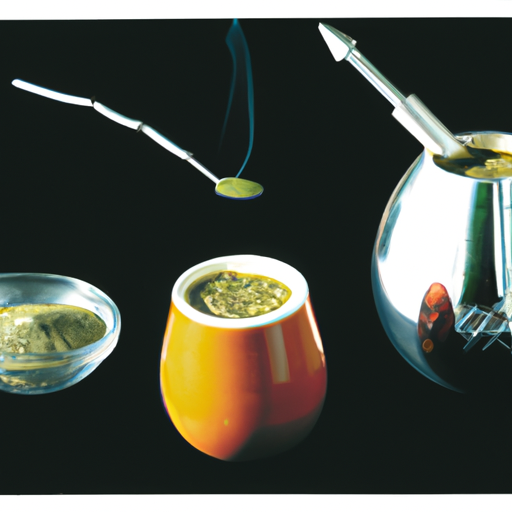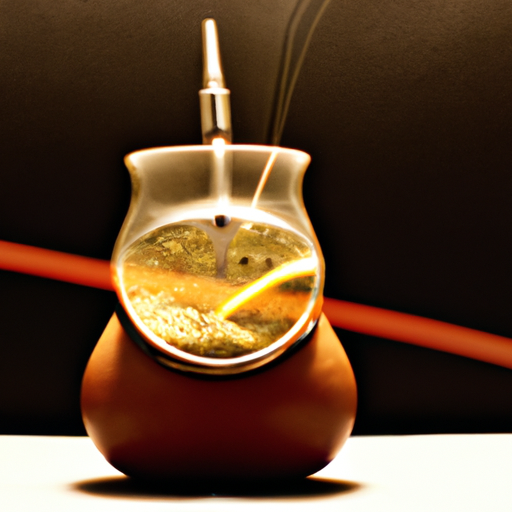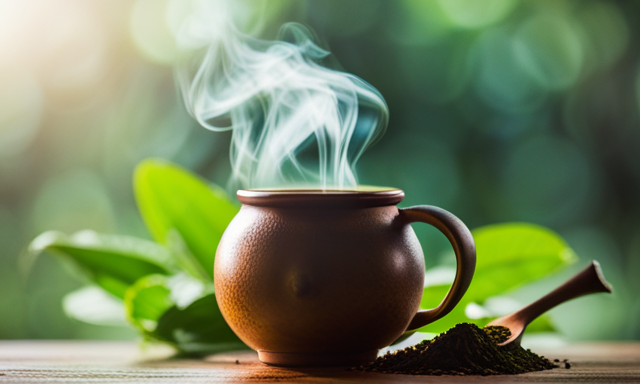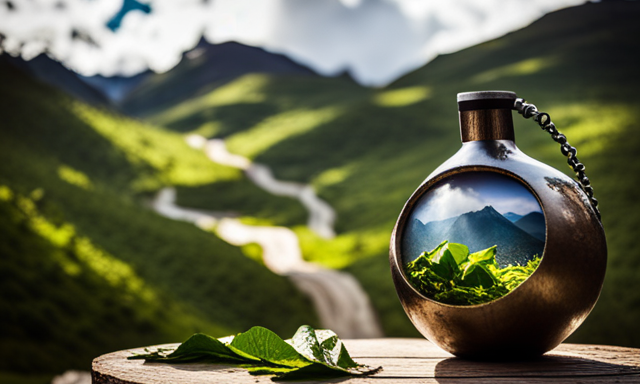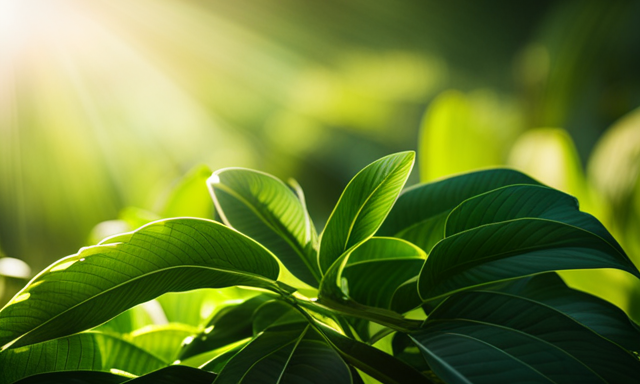I really enjoy yerba mate, a classic beverage from South America that’s becoming more popular in the US and other places. It offers a distinct taste that is earthy, grassy, with a hint of bitterness, yet it’s also invigorating and refreshing. Its high caffeine level distinguishes it from other types of teas and coffees, providing a natural energy lift without causing any nervousness.
In this article, I’ll dive into the topic of how much caffeine is in yerba mate, as well as other factors that affect its potency and health benefits. Whether you’re new to yerba mate or already hooked on it like me, understanding its caffeine content can help you make informed choices about when and how to enjoy it.
So let’s get started!
Key Takeaways
- Yerba mate has a high caffeine content, less than coffee but more than black or green tea.
- Consuming too much caffeine can lead to jitteriness, headaches, and insomnia.
- Excessive yerba mate consumption can increase the risk of esophageal, lung, and bladder cancers due to the high temperature at which it is typically consumed and the presence of certain carcinogenic compounds.
- Factors such as soil quality and harvesting techniques can affect caffeine levels in yerba mate.
What is Yerba Mate?
Do you know what yerba mate is and how it can give you a boost of energy without the crash?
Yerba mate is a traditional South American drink that has been consumed for centuries. It’s made from the leaves of the yerba mate plant, which grows in countries like Argentina, Brazil, and Paraguay. This beverage has become increasingly popular worldwide because of its many health benefits.
Yerba Mate history dates back to ancient times when indigenous communities used it for medicinal purposes. They believed that drinking this tea could cure numerous ailments such as headaches, fever, and digestive problems.
Today, yerba mate is still an essential part of South American culture and has even inspired social rituals like mateadas, where friends gather around a gourd filled with hot water and pass it around to share.
Cultivation practices for yerba mate vary depending on the region where it’s grown. Farmers use traditional methods such as shade-grown techniques or more modern approaches that involve fertilizers and pesticides. However, one thing remains constant: they take great care in selecting only the best leaves to ensure high-quality yerba mate production.
Now let’s explore the caffeine content in yerba mate, another factor that makes this beverage so unique!
Caffeine Content in Yerba Mate
You’ll be pleasantly surprised by the energizing boost you get from sipping on a cup of this traditional South American beverage. Yerba mate is packed with caffeine, making it a popular alternative to coffee and tea for those seeking an energy boost. The amount of caffeine in yerba mate can vary depending on factors such as the type of yerba mate, how it’s prepared, and the serving size.
To give you an idea of how much caffeine is in yerba mate compared to other beverages, take a look at this table:
| Beverage | Caffeine Content (mg) |
|---|---|
| Yerba Mate | 30-50 |
| Coffee | 95-165 |
| Black Tea | 25-48 |
| Green Tea | 25-29 |
As you can see, yerba mate has significantly less caffeine than coffee but more than black or green tea. It’s important to note that while yerba mate may not have as much caffeine as coffee, it can still have an impact on sleep if consumed too close to bedtime.
Yerba mate is a refreshing and energizing beverage that contains moderate amounts of caffeine. Its caffeine content falls somewhere between that of black/green tea and coffee. However, it’s important to be mindful of the effects on sleep when consuming any caffeinated beverage. In the next section, we’ll explore some factors that affect the caffeine content in yerba mate.
Factors that Affect Caffeine Content
When it comes to the kick you get from your yerba mate, there are a few factors that can play into how strong it is. Just like how the weather can affect the strength of a wave, brewing temperature and steeping time can impact the caffeine content in your cup of mate.
Additionally, factors such as soil quality and harvesting techniques can also affect caffeine levels in your yerba mate. Soil quality plays a significant role in determining plant health and nutrient content. The same goes for yerba mate plants; their caffeine content depends on the nutrients they receive from the soil they grow in. Yerba mate grown in mineral-rich soils tends to have higher caffeine levels than those grown in nutrient-deficient soils.
The processing method used for yerba mate also affects its caffeine levels and flavor profile. For example, roasted yerba mate has lower caffeine levels compared to unroasted varieties due to oxidation during roasting. On the other hand, smoked yerba mates have a unique smoky flavor but may contain lower amounts of caffeine due to oxidation during smoking.
Understanding these factors helps us choose our desired type of yerba mate based on taste preferences or desired energy boost. Understanding these factors can help you choose which type of yerba mate is best for you based on taste preferences or desired energy boost. In addition to its energizing effects, drinking yerba mate has been associated with several health benefits, which we’ll explore next.
Health Benefits of Yerba Mate
I’m excited to discuss the health benefits of yerba mate, as there are many!
Yerba mate contains antioxidants and nutrients that can help protect against disease. It’s also been shown to potentially aid in weight loss, improve digestion, and boost the immune system.
Antioxidants and Nutrients
Did you know that yerba mate contains not only caffeine, but also a variety of antioxidants and nutrients such as polyphenols and vitamins? These compounds have been shown to provide numerous health benefits including antioxidant protection against oxidative damage caused by free radicals.
Polyphenols, in particular, are associated with reduced risk of chronic diseases such as cancer and cardiovascular disease.
Apart from its antioxidant benefits, yerba mate also boasts impressive nutrient content. It’s rich in vitamins B1 (thiamine), B2 (riboflavin), and B3 (niacin), which play important roles in energy metabolism. Additionally, it contains minerals such as potassium, magnesium, and manganese that contribute to overall health.
With all these beneficial compounds present in yerba mate, it’s no wonder why this beverage has gained popularity among health enthusiasts as a potential weight loss aid.
Potential Weight Loss Aid
You may be surprised to learn that this South American beverage could potentially help you shed a few pounds. In fact, a study published in the Journal of Human Nutrition and Dietetics found that participants who consumed yerba mate before meals had a significantly lower BMI compared to those who didn’t.
Not only does yerba mate contain caffeine, which can boost metabolism and increase fat burning, but it also contains compounds called saponins and polyphenols that have been shown to aid in weight loss. However, it’s important to note that while yerba mate may have potential benefits beyond weight loss, there are also potential drawbacks.
Consuming too much caffeine can lead to jitteriness, headaches, and insomnia. Additionally, some studies have suggested that high consumption of hot beverages like yerba mate could increase the risk of esophageal cancer. Therefore, it’s important to consume yerba mate in moderation and consult with a healthcare professional if you have any concerns about its effects on your health.
With that said, let’s move on to how yerba mate can improve digestion and support the immune system.
Improved Digestion and Immune System
Boost your digestive health and enhance your immune system by incorporating yerba mate into your daily routine. This South American drink is packed with nutritional benefits that can help improve various aspects of our overall health.
Here are some ways in which yerba mate can benefit our digestive and immune systems:
- Yerba mate contains compounds such as saponins, which have anti-inflammatory properties that can help alleviate gastrointestinal inflammation. Additionally, it has been found to stimulate the production of bile and other digestive enzymes, which can aid in the digestion of fats.
- The high antioxidant content in yerba mate can also help strengthen our immune system by protecting our cells from damage caused by free radicals. Plus, its caffeine content may boost energy levels and alertness, helping us stay active and healthy.
To fully reap the nutritional benefits of yerba mate, it’s important to brew it correctly. Using hot (but not boiling) water and steeping for a few minutes will extract the maximum amount of nutrients from the leaves. However, be mindful not to overdo it on caffeine intake as excessive consumption may lead to negative side effects.
Moving on to discussing potential side effects of yerba mate…
Side Effects of Yerba Mate
As someone who regularly consumes yerba mate, it’s important to be aware of the potential side effects.
One of the most common issues is caffeine sensitivity, which can lead to jitters, rapid heartbeat, and difficulty sleeping.
Additionally, there have been some concerns about a possible link between yerba mate consumption and certain types of cancer.
It’s also important to note that yerba mate can interact with certain medications, so it’s always best to consult with a healthcare provider before incorporating it into your routine.
Caffeine Sensitivity
Some people may have a surprising sensitivity to the stimulating effects of caffeine found in yerba mate. This can lead to various symptoms such as increased heart rate, anxiety, and sleep disturbances. If you notice any of these symptoms after consuming yerba mate, it’s possible that you’re sensitive to caffeine.
To understand caffeine sensitivity better, here are three key points to keep in mind:
-
Caffeine sensitivity varies from person to person. While some people can consume large amounts of caffeine without experiencing any adverse effects, others may feel jittery and anxious even with small doses.
-
Genetics play a role. Studies have shown that certain genetic variations may increase or decrease an individual’s sensitivity to caffeine.
-
Other factors also influence caffeine sensitivity. Factors such as age, body weight, medication use, and smoking habits can affect how one responds to caffeine.
Therefore, if you experience any negative symptoms after consuming yerba mate or other caffeinated beverages, it’s important to pay attention and consider reducing your intake.
In the next section, we’ll explore another potential risk associated with excessive yerba mate consumption – the risk of cancer.
Risk of Cancer
Uh oh, drinking too much of that South American beverage could up your risk for cancer. Yerba mate has been linked to an increased risk of certain types of cancer, including esophageal, lung, and bladder cancers. This is due in part to the high temperature at which yerba mate is typically consumed, as well as the presence of certain carcinogenic compounds.
However, it’s important to note that research on the link between yerba mate and cancer risk is still ongoing and not definitive. Additionally, some studies have suggested that caffeine intake may actually have a protective effect against certain types of cancer. As with any food or beverage, moderation is key when it comes to consuming yerba mate. It’s also important to speak with a healthcare professional if you have concerns about your caffeine intake and how it may be affecting your overall health.
Moving on to interaction with medications…
Interaction with Medications
Be aware of potential medication interactions when consuming yerba mate, as it can affect the way your body metabolizes certain drugs. Yerba mate contains caffeine and other compounds that can interact with medications for various conditions such as anxiety, depression, and high blood pressure.
The metabolism of these medications may be affected by the caffeine in yerba mate, which could lead to increased side effects or decreased effectiveness. It’s important to consult with a healthcare provider before drinking yerba mate if you’re taking any prescription medications.
They can advise you on whether it’s safe to consume yerba mate while taking your medications and provide guidance on adjusting dosages or timing of medication intake. By being informed about potential risks associated with interactions between yerba mate and medications, you can make an informed decision about whether to include this beverage in your diet.
Now let’s move onto how to choose the best yerba mate for your needs.
How to Choose the Best Yerba Mate
When it comes to choosing the best yerba mate, I always keep an eye out for organic and fair trade options. They’re not only better for the environment and farmers, but they also tend to have a more robust flavor profile.
Speaking of flavor profiles, I also like to look for blends that incorporate other herbs or spices for a unique taste experience.
Of course, quality and freshness are crucial factors as well. Nobody wants stale or low-quality mate!
Organic and Fair Trade Options
Looking for an ethical and sustainable option? Try out organic and fair trade yerba mate to get your caffeine fix!
Organic certification guarantees that the yerba mate was grown without harmful chemicals or pesticides, promoting a healthy environment for both the consumers and growers. Choosing fair trade practices ensures that farmers are paid fairly for their work, providing better living conditions and economic stability for their families.
Not only is organic and fair trade yerba mate a responsible choice, but it also offers unique flavor profiles and blends. Depending on the region where it is grown, yerba mate can have different taste notes ranging from earthy to floral. Popular blends include those with added herbs or fruits such as lemon verbena or orange peel.
Exploring different blends can add variety to your daily routine while still maintaining the benefits of organic and fair trade practices.
Flavor Profiles and Blends
Exploring different blends of organic and fair trade yerba mate can reveal a range of unique flavor profiles. Some regions produce more floral notes while others lean towards earthy tones. I’ve discovered that my personal favorite blend is one with hints of citrus and mint, which provides a refreshing twist to the traditional taste.
Additionally, experimenting with brewing techniques such as steeping time and temperature can also affect the overall flavor profile. To further enhance my yerba mate experience, I’ve also tried mixing different flavors together to create new and exciting combinations. For example, combining yerba mate with lavender or vanilla adds a subtle sweetness that complements the natural bitterness of the tea.
Overall, playing around with different flavor combinations and brewing techniques has allowed me to enjoy yerba mate in new ways that suit my taste preferences. With all this talk about flavor profiles, it’s important to note that quality and freshness are crucial factors in determining how good your yerba mate tastes.
Quality and Freshness
Moving on to the current subtopic, when it comes to yerba mate, quality and freshness are crucial factors to consider. As a devoted yerba mate drinker, I can attest to the fact that nothing ruins a cup of yerba mate faster than stale or low-quality leaves. That’s why reputable brands put significant effort into ensuring their products undergo rigorous quality control measures.
To ensure top-notch quality, companies employ various sourcing methods such as working directly with farmers or cooperatives and conducting regular inspections at every stage of production. By doing so, they guarantee that only the finest leaves make it into your cup. Additionally, these measures help promote sustainable practices in the industry while also contributing positively to local communities.
With this level of attention paid towards sourcing and quality control, you can be sure that you’re getting high-quality yerba mate every time you brew a cup.
Now that we’ve covered how important quality and freshness are when it comes to yerba mate, let’s dive into the next section about how to brew it properly for maximum flavor and enjoyment.
How to Brew Yerba Mate
To brew yerba mate, all you need is loose-leaf yerba mate, a gourd or cup, and a bombilla. The brewing technique for yerba mate is not as complicated as other tea varieties.
First of all, fill about two-thirds of the gourd with loose-leaf yerba mate and shake it gently to let the smaller particles sink to the bottom.
Next, insert the bombilla into the gourd at an angle so that it touches the bottom of the gourd without disturbing the leaves. Pour hot water (not boiling) into the empty space in the gourd until it reaches near the top.
Let it sit for a few minutes to allow for steeping before drinking. The flavor variations will depend on how strong you make your brew and how long you allow it to steep.
After learning how to brew yerba mate, you can now move on to serving it properly. Yerba mate is traditionally served in a group setting where one person prepares and serves while others enjoy and pass around the shared vessel.
Serving this South American drink also comes with its own set of etiquette rules such as not stirring or shaking the leaves once they are in place. Overall, brewing and serving yerba mate can be seen as a ceremonial experience that brings people together over a warm cup of tea-like infusion.
How to Serve Yerba Mate
Serving yerba mate is like orchestrating a symphony, with each person playing their part in the ritual of passing around the shared vessel and enjoying the warm, earthy infusion.
Before serving, it’s important to remember that yerba mate has its own set of rituals and brewing techniques. The traditional method involves using a gourd, bombilla (straw), and loose-leaf yerba mate.
To start, fill the gourd about two-thirds full with yerba mate leaves. Tilt it slightly so that one side is higher than the other. This creates an area for the water to be poured without washing away the leaves.
Next, fill this emptied space with cool water before adding hot water at 160-180°F to cover about half of the gourd’s contents.
Finally, insert your bombilla into this space and sip through it until all liquid is consumed.
There are many variations on this method depending on personal taste preference or cultural customs but mastering one can lead to a more enjoyable drinking experience. After mastering these techniques you can start experimenting with different ingredients to make your own unique yerba mate recipes!
Yerba Mate Recipes
I’m excited to share with you some delicious Yerba Mate recipes that I’ve discovered, including traditional preparations, cocktails and mocktails, and food pairings.
For those interested in the traditional way of serving Yerba Mate, I’ll be sharing some tips on how to prepare it like the locals do in South America.
If you’re looking for something a bit more unconventional, I’ll also be sharing some unique cocktail and mocktail recipes that incorporate Yerba Mate.
And finally, I’ll discuss which foods pair well with this beloved beverage to enhance your overall drinking experience.
Traditional Preparations
You’ll be amazed at the caffeine content found in traditional yerba mate preparations, giving you the energy boost you need to power through your day.
In traditional South American cultures, yerba mate is often prepared in a gourd-shaped vessel called a mate and sipped out of a metal straw called a bombilla. Drinking rituals vary from country to country, but generally involve passing the gourd around in a circle among friends or family.
The preparation process involves steeping dried leaves and twigs of the yerba mate plant in hot water for several minutes before sipping. The resulting beverage has a bitter, earthy taste that can take some getting used to, but many people find it an enjoyable alternative to coffee or tea.
With its high levels of caffeine and other stimulating compounds like theobromine and theophylline, it’s no wonder why yerba mate has been used as an energy booster for centuries.
As we move on to cocktails and mocktails with yerba mate, you’ll discover new ways to enjoy this versatile drink beyond just sipping it from a gourd.
Cocktails and Mocktails
Get ready to elevate your drinking experience with yerba mate by trying out some delicious cocktails and mocktails! While traditional preparations of yerba mate involve simply steeping the leaves in hot water, there are many ways to incorporate this South American beverage into more complex drinks. Yerba mate can add a unique earthy flavor and a boost of caffeine to any cocktail or mocktail.
Check out these yerba mate cocktail recipes and mocktail options:
| Cocktail | Ingredients |
|---|---|
| Matejito | – 1 handful mint leaves – 1 lime, cut into wedges – 2 oz white rum – 4 oz cold brewed yerba mate – ice |
| Yerba Mate Margarita | – 2 oz tequila – 3 oz cold brewed yerba mate – juice of half a lime – splash of orange liqueur |
| Mocktail | Ingredients |
|---|---|
| Sparkling Yerba Mate Lemonade | – juice of half a lemon – 6-8 oz sparkling water – 3-4 oz cold brewed yerba mate – honey or agave syrup (optional) |
These are just a few examples, but the possibilities are endless when it comes to incorporating yerba mate into your drinks. Experiment with different flavors and ingredients to create unique and flavorful cocktails or mocktails.
Now that we’ve explored some tasty drink options with yerba mate, let’s move on to the next section about food pairings.
Food Pairings
Let’s explore the delicious world of pairing yerba mate with food, where flavors come alive and taste buds dance with excitement. Did you know that in South America, yerba mate is often paired with dulce de leche, a caramel-like spread made from milk and sugar? The sweet and creamy flavor of dulce de leche complements the earthy taste of yerba mate perfectly.
Another popular pairing is empanadas, a savory pastry filled with meat or vegetables. Yerba mate helps cut through the richness of this dish and enhances its flavors.
When it comes to brewing techniques for yerba mate, there are different methods depending on personal preferences. Some people prefer to drink it hot while others enjoy it chilled as terere. Pairing cold terere with grilled meat is a favorite among Argentinians. The refreshing taste of terere helps balance out the heaviness of the meat, making it a perfect combination for barbecue lovers.
In addition, fruits like citrus or berries can enhance the fruity notes in yerba mate and create a well-balanced flavor profile when brewed together. With so many delicious food pairings and brewing techniques available, exploring yerba mate’s versatility has never been more exciting!
Frequently Asked Questions
Is yerba mate safe for pregnant women to consume?
As a pregnant woman, I’ve been curious about the safety of consuming yerba mate. After researching, I’ve found conflicting information on whether it’s safe or not.
Some studies suggest that high levels of caffeine consumption during pregnancy may lead to complications such as low birth weight and miscarriage. However, there are no definitive studies linking moderate caffeine intake from yerba mate specifically to negative pregnancy outcomes.
It’s important to note that yerba mate does contain caffeine and should be consumed in moderation during pregnancy. As for breastfeeding mothers, limited research suggests that moderate consumption of yerba mate is unlikely to affect milk production or infant development.
Ultimately, it’s best to consult with a healthcare provider before consuming any caffeinated beverage while pregnant or breastfeeding.
Can yerba mate be used as a weight loss supplement?
Personally, I’ve found that using yerba mate as a weight loss supplement has been effective in boosting my metabolism.
The weight loss effects of yerba mate can be attributed to its caffeine content, which stimulates the central nervous system and increases energy expenditure.
Furthermore, yerba mate contains compounds such as polyphenols and flavonoids that may also aid in weight loss by reducing inflammation and improving insulin sensitivity.
However, it’s important to note that yerba mate should not be relied upon solely for weight loss and should be used in conjunction with a healthy diet and exercise regimen.
Additionally, it’s important to be mindful of the amount of caffeine consumed from yerba mate, as too much can lead to negative side effects such as increased heart rate and anxiety.
How does yerba mate compare to other caffeinated beverages in terms of taste?
In terms of taste comparison, yerba mate has a unique flavor profile that sets it apart from other caffeinated beverages. While coffee tends to have a bitter taste and tea can be floral or earthy, yerba mate has a distinct herbal flavor with notes of grass and smoke. Some people also describe its taste as slightly nutty or reminiscent of toasted bread.
The flavor can vary depending on the specific brand or preparation method used, but overall it is often described as bold and robust. If you’re looking for a caffeinated drink with a strong taste that’s different from traditional coffee or tea, yerba mate could be worth trying out for its unique flavor notes.
Are there any cultural traditions associated with drinking yerba mate?
When it comes to drinking yerba mate, there is a rich cultural significance tied to the beverage. As someone who’s grown up in a Latin American household, I’ve learned about the importance of mate drinking etiquette and how it plays a crucial role in social interactions.
In many South American countries, sharing mate with friends or family members is a way of showing hospitality and building community. There are even specific rules around how to prepare and serve mate, such as passing the gourd clockwise and never stirring the straw.
These traditions add depth and meaning to something as simple as enjoying a cup of tea with loved ones.
Can yerba mate be consumed cold or does it always need to be brewed hot?
I’ve found that yerba mate can definitely be consumed cold, and there are actually many different ways to prepare it this way. Cold preparation involves either steeping the yerba mate in cold water for an extended period of time or using a French press to make a concentrate that can then be diluted with cold water.
This method can result in a smoother and more refreshing flavor compared to hot brewing. Additionally, there are also various flavor variations that can be added to the cold-brewed yerba mate such as citrus fruits or even mint leaves for a unique twist.
Conclusion
So, how much caffeine is in yerba mate? After researching and learning about this traditional South American drink, I’ve found that the answer can vary. On average, a cup of yerba mate contains around 30-50 milligrams of caffeine. However, factors such as brewing time and method can affect the amount of caffeine present.
Despite its varying caffeine content, yerba mate offers many health benefits, such as boosting energy levels and aiding digestion. It also has some potential side effects, such as increasing heart rate and blood pressure. When choosing a yerba mate product, it’s important to consider its quality and origin to ensure you’re getting the best possible experience.
One interesting statistic to note is that according to a study published in the Journal of Food Science and Technology, yerba mate contains more antioxidants than green tea. This highlights the potential health benefits that come with consuming this beverage.
Overall, understanding the caffeine content and other aspects of yerba mate can help individuals make informed decisions when incorporating it into their daily routine.

